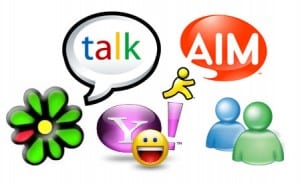As the Internet continues to grow and spread, electronically mediated communication is becoming a more familiar part of everyday life. Email addresses appear on everything from billboards to cereal boxes, and a URL is as necessary as a phone number (sometimes, more so.) Similarly, as new forms of computer-mediated communication (CMC) emerge, they become part of the complex fabric of communication channels available to us, in both our working and personal lives.
One of the most notable new forms of communication to have attained significant critical mass is Instant Messaging (IM). Instantaneous virtual text messaging is not new; similar facilities were incorporated into mainframe and minicomputer operating systems of earlier decades. Internet-based Instant Messaging is nonetheless a relatively new phenomenon, especially in terms of its user base. Spurred not least by early adoption among teens and young adults, Instant Messaging technologies have found their way into home and office life.
In trying to explain why Instant Messaging has been so widely adopted, advocates note the convenience, speed, and especially the informality of IM communication as features that separate it from alternatives such as face-to-face or email interaction. There is, however, a conundrum here. For those of us who are familiar with the history of the adoption of electronic mail, the idea of IM as a more “informal” medium than email seems ironic, since email used to be touted as an informal medium itself. For instance, in his plenary presentation at the first Computer-Supported Cooperative Work conference in 1986, John Seely Brown jokingly suggested that email servers should deliberately introduce spelling errors into email messages, in order to maintain the informal nature of email communication.
In our research, we have been examining the use of Instant Messaging by teens and college-students, who often remark on the informal nature of IM interaction. Consequently, we have become interested in this conundrum. In this article, we explore the question from two perspectives, and suggest that the traditional, media-oriented view of formality in interaction may not be as enlightening as an alternative, institutional view.
 Instant Messaging and its Use
Instant Messaging and its Use
Most readers are probably familiar with the basics of Instant Messaging technology. IM systems such as AOL Instant Messenger (AIM), MSN Messenger, and ICQ (“I-seek-you”) are based on two key components. First, they provide near-instantaneous message delivery across the Internet, supporting synchronous “chat” conversations. Second, they provide a number of mechanisms for establishing presence and privacy. IM users are identified through “handles” or “screen names” which can be associated with pictures and text descriptions. A buddy list shows Instant Messaging users which of their friends (known as “buddies”) are online, and whether they’re active or idle. Away messages enhance the presence information by allowing a user to describe their availability. Finally, blocking allows users to control their visibility to others.
Characterization of Instant Messaging
Studies of Instant Messaging often characterize conversations as lightweight, brief, and above all else, casual. While these studies note adoption differences between teens and adult users, their descriptions of Instant Messaging conversations remain fairly consistent. They suggest that the informality of Instant Messaging communication is one of the important features by which people distinguish it from other communication technologies, and indeed that they choose to use it for conversations which they would like to maintain this informal character.
However, as we have hinted, this characterization of Instant Messaging as an informal medium is surprising from a broader perspective. In particular, the formality of Instant Messaging communication is often contrasted with the relative formality of email. This seems odd because a large body of literature documenting the arrival and adoption of email in the late 1970s and early 1980s points to informality as one of the primary characteristics of electronic mail. For instance, in their classic book Connections, Sproull and Kiesler note that “computer-mediated communication seemed much like the telephone, which to a degree also permits open, informal interaction” or again, that electronic mail “gives [isolated workers] the opportunity to share in informal conversations and exchanges of information that help build commitment to the organization and foster social control”. These comments are almost identical to recent observations about Instant Messaging technologies.
This raises some interesting questions:
- What gives rise to these arguments?
- Is Instant Messaging merely more informal than email?
- Has the perception of electronic mail changed?
- Has the use of email changed?
There are a number of possible explanations. We discuss two here. The first, drawing on media richness theory, attributes the patterns of communication and interpretation to the features of the medium through which that communication is conducted. The second takes an institutional perspective and looks outside the Instant Messaging medium itself to examine the settings within which the technology is encountered and used.
